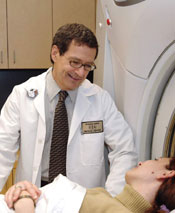Myocardial perfusion imaging by CT a promising diagnostic, prognostic tool
Although the literature and data regarding the prognostic and diagnostic ability – as well as the wider applicability – of CT perfusion imaging is still being collected, produced and published, some researchers said they feel that the results are trending in a direction that bodes well for wider application of the modality.
Coronary CT is used primarily to assess the coronary arteries, as well as to search for plaque or stenoses. Myocardial perfusion imaging by CT has often been compared by researchers (and also in studies of the technique) with nuclear perfusion imaging. Results from some recently published studies suggested that perfusion imaging with CT may have some wider advantages, but the larger trials needed to confirm these potential advantages are still being conducted.
Myocardial perfusion imaging using CT, like other modalities, has specific strengths. According to Jack Ziffer, MD, PhD, president of the Society for Cardiovascular Computed Tomography (SCCT) and director of cardiac imaging at Baptist Cardiac and Vascular Institute in Miami, perfusion imaging has a high sensitivity and negative predictive value. Perfusion imaging is also particularly effective at characterizing and evaluating patients with abnormal CT scans, from which it can derive clinically valuable information.
“In general, the reason for using perfusion is to test whether myocardial blood flow is normal or not, and the principle clinical advantage of that is when assessing patients of chest pain syndrome, we may incidentally find CAD that has nothing to do with their symptoms,” Ziffer told Cardiology Today. “We would want to know if intermediate lesions were flow-limiting or not, and perfusion is very good for that.”
|
Source: Cedars Sinai Department of Medical Media |
Ziffer said that despite the fact that data supporting perfusion imaging’s wider application are thin, cardiologists are conscious of the modality’s potential.
“We look to CT as a diagnostic test, and it is rapidly developing into a potentially powerful prognostic assessment that will help direct therapy,” Ziffer said. “There will be developments that early on will help identify the right patients who will benefit, with the potential for much more broad-based application, so physicians should keep their eyes open.”
The available literature consists of smaller, prospective studies rather than large, multicenter trials and a limited set of trials and studies whose results have indicated the diagnostic and prognostic ability of myocardial perfusion imaging using CT.
“CT perfusion imaging is really in the initial phase of validation, and although there is a growing body of evidence for CT perfusion imaging, it is preliminary data,” Ricardo Cury, MD, director of cardiac MRI and cardiac CT at Baptist Cardiac and Vascular Institute in Miami, told Cardiology Today.
Cury has been part of several groups of researchers working on various CT myocardial perfusion studies. In one abstract presented at the American Heart Association 2008 Scientific Sessions, his group laid out a protocol for performing the simultaneous application of both rest and stress myocardial perfusion together with coronary CTA. They reported that adenosine stress CT can identify stress-induced myocardial perfusion defects with a diagnostic accuracy comparable with that of single photon–emission CT.
“There are some limitations that will have to be improved,” Cury said. “For example, the CT perfusion artifacts are mainly related to beam-hardening and motion artifacts. For CT perfusion, they can decrease the diagnostic accuracy.”
Another problem practitioners face is the lack of a widely applied methodological consistency for the modality.
“We do not yet have standardized protocols for how to do myocardial perfusion imaging with CT,” Dan Berman, MD, immediate past president of the SCCT and director of cardiac imaging at Cedars-Sinai Medical Center in Los Angeles, said in an interview. “We do not have methods for quantifying the abnormalities yet as compared with, for example, nuclear scanning that has been done in millions of people and has a large database supporting the importance of the perfusion defect presence and size.”
According to Cury, perfusion imaging could potentially be used as a comprehensive test that acquires the important information gained from a nuclear scan and CTA, ultimately enabling the physician to use the results of a myocardial perfusion scan to make decisions about therapy.
“With a single image modality, you would be able to provide information on stenosis, plaque and on top of that, ischemia and viability,” Cury said.
Berman said that should the data from upcoming studies of perfusion imaging turn out to be supportive, the potential downstream effect could be significant.
“Perhaps the most important thing is that we could take the application of CT and expand it beyond the relatively limited group of patients who benefit right now — particularly to those with the low intermediate likelihood of disease — and apply it to a broader spectrum of patients with known or suspected CAD,” Berman, a member of the Cardiology Today editorial board, said. “Speculating even farther down the line, it is possible that a CT scan alone could end up allowing us to rule out the presence of high-risk coronary disease for which the patient has to go to the cath lab.”
The effects could also be felt from the standpoint of health care payers. Acquiring the information in one scan where it may have previously taken two or three can save money.
“Being able to answer the question early on as for the need for sequential testing is advantageous,” Ziffer said. “Having a comprehensive test would hopefully avoid unnecessary downstream testing that may lead to intervention.” – by Eric Raible

